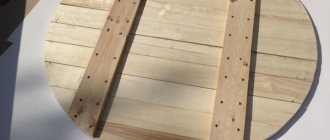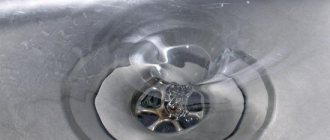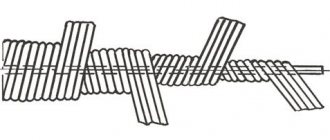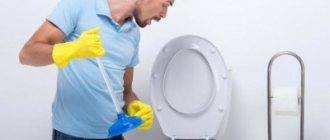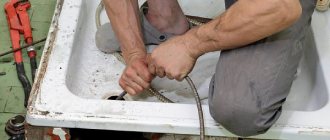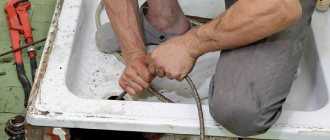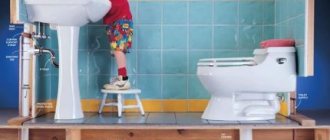A lovingly made renovation in the kitchen, carefully selected interior decor elements, beautiful dishes - in the morning you usually don’t want to leave your cozy nest. So you went out into the kitchen in the morning, prepared to make yourself a cup of coffee and some... What is that unpleasant smell coming from the sink? Let's let the water through - that's right, the water doesn't go away! Instead of morning bliss, we have a clog in the kitchen sink, what should we do, call a plumber or try to deal with it ourselves? The answers are in our article.
First, let us reassure you that most blockages can be eliminated on your own , without calling specialists. There are several methods; if in your case one of the selected options does not turn out to be effective enough, you can use another. Also, at the end of our article, we’ll talk about preventing clogs in the kitchen sink.
Who is to blame and what to do?
Two eternal Russian philosophical questions are quite applicable to our situation. First , check whether there is a special mesh on the sink drain that does not allow food debris, large fractions of vegetable peels, hair and pet hair to freely penetrate into the sewer pipe and form such a delicious plug there, mixing with fat.
If there is no mesh , only you are to blame, how to remove the blockage - urgently go to the hardware store for a miracle mesh.
But there may well be a situation where the fat washed off from the dishes remains on the walls of the sewerage elements and catches the smallest food debris and so on. A clog forms, just not so quickly, not once a week, but once a year , and then one day, not a wonderful day, the water stands in the sink, and the plastic mesh, on which so much hope is placed, drifts on the surface of the water.
What should I do? Let's roll up our sleeves and get down to business.
But the owners are not always to blame; let’s list all the causes of blockages:
- the fine litter already mentioned above (food remains, fat, threads, hair);
- corrosion of pipes (typical of old housing stock);
- defects in the operation of the sewer system (improper installation of the siphon, depressurization of the pipeline, etc.).
In our article we will analyze options for action for the first, most common reason. If old pipes are corroded, they become brittle - in this case, they should be replaced with more modern building materials (in a plastic pipe, for example, there will be no such deposits).
If there are defects in the sewer system, specialists should be invited to diagnose and fix the problem.
Why does the water drain poorly from the kitchen sink?
When the water in the kitchen sink does not drain, not every housewife knows what to do. A clogged sink leaves no way to wash dishes and fills the kitchen with an unpleasant odor.
A clogged sink leaves no way to wash dishes.
Why doesn't the water go away?
Water does not drain well from the sink only because it is clogged. However, there can be any number of sources of blockage. Most often, the drain becomes clogged with a lump of food debris, fat, hair, detergents, which gradually collect in the siphon, grow on its walls and narrow the lumen.
In addition, all sorts of small objects can get into the pipe: pieces of paper, paper clips, buttons, bottle caps, parts of a children's construction set. They can get stuck not only in the siphon, but also in any other place in the drain, preventing complete drainage. The method for eliminating it depends on the cause of the blockage. Therefore, before starting to solve the problem, it is recommended to determine its source.
Folk remedies for cleaning pipes
There are folk remedies that traditionally help maintain kitchen drain hygiene without the use of industrial chemicals.
https://www.youtube.com/watch?v=_YkSOHTgBFQ
Recipe No. 1 Soda + vinegar
Before you start cleaning with baking soda and vinegar, you need to remove all accumulated water from the sink. After this, approximately 100 g of baking soda is poured into the drain and 1 glass of table vinegar is poured. For greater effect, the drain should be closed with a stopper and left for 30-40 minutes. After this time, 2 liters of boiling water is poured into the sink. If after these steps the blockage is not completely cleared, you can use a plunger.
Recipe No. 2 Soda + salt + boiling water
Using this method, you also need to drain the sink. Next, half a glass of table salt and the same amount of baking soda are poured into the drain. Then 0.5 liters of boiling water is poured there, closed with a stopper or a damp cloth and left for 5-8 hours. It's best to do this overnight so that you have a clean and working sink in the morning. After the waiting period has passed, the drain should be rinsed with warm water.
How to clear a blockage mechanically
There are several ways to mechanically clear a clogged kitchen sink. They are simple, but require physical effort.
Using a plunger
If the drain is slightly clogged, when the water slowly but still drains away, it is best to use a plunger. It allows you to pump out water and air, gradually moving and destroying the formed lump. The scheme for working with a plunger is as simple as possible. The tool must be applied to the drain and pressed against the surface of the sink with a series of sharp pushes. If the plumbing has two drains, then you can work with a partner, armed with two plungers. When this is not possible, the second drain is covered with a damp rag or stopper.
If the drain is slightly clogged, when the water slowly but still drains away, it is best to use a plunger.
Cleaning with a cable
Cable cleaning is used in the most difficult cases, so its effectiveness is beyond doubt. A special cable can be purchased at a hardware store. When choosing a tool, preference should be given to a model with a comfortable handle, since working with such a cable will be the most comfortable and effective. High-quality cables are made from high-strength steel, which is resistant to corrosion and all kinds of damage. The service life of such a tool exceeds several decades.
The scheme for working with the cable is clear and accessible. The brush or hook located at the end of the tool is carefully inserted into the drain hole. After this, the cable is gradually pushed into the pipe, slowly turning the handle. As soon as the working end encounters a blockage, you should push it inside with a precise and sharp movement, thereby destroying the formed lump. Working with the cable requires some effort and skill, but its effectiveness exceeds expectations.
Basic cleaning methods
There are four reliable ways to clear a clogged sink:
- mechanical;
- chemical;
- hydrodynamic;
- using home remedies.
Below we will analyze in detail each of the popular options. The hydrodynamic method is the least popular, since hydrodynamic sewer cleaning is carried out with special devices; it is an effective cleaning method, but the devices themselves are not very common.
To begin with, you can run a sufficient amount of hot water, the fat will dissolve, if the plug is small, it will break up and go through the pipes. In the future, it will only be necessary to carry out preventive measures to avoid clogging; we will discuss them below.
If hot water does not clear the blockage, then the problem is more serious; we will solve it in other ways.
Removing a clog in the kitchen sink
How to disassemble and clean the sink siphon - the simplest and most reliable way to remove a blockage
If you have already tried to break through the blockage in the sink using folk or chemical remedies, but the water still stands or drains slowly, then most likely you need to clean the siphon. Fortunately, even a child can take it apart. All you need is: 15 minutes of free time and a screwdriver or coin.
Step 1. Unscrew the nut that is located above the siphon reservoir and carefully remove it.
- It is advisable, before disassembling the siphon, to place a basin under it for occasional puddles and to collect dirt. And, of course, don't forget to wear rubber gloves.
Step 2. Hold the siphon in one hand, and with the other hand disconnect the drain hose, unscrewing the nut between them. Next, we move the siphon and drain hose to the side (for example, into a basin), and at the same time remove the dirt that falls out of them.
Step 3. Now unscrew the drain grate in the sink using a screwdriver or coin (most modern grates can be unscrewed with a coin).
Step 4. Unscrew the top nut on the remaining pipe and take it out of the sink along with the already unscrewed drain grate. Hooray! The siphon is disassembled.
Step 5. Wash all the parts. To thoroughly clean the siphon, unscrew the flask from it.
Step 6. We assemble the siphon in the reverse order: install the drain grate and pipe, secure it with a nut, then assemble the siphon, connect it to the drain hose and, finally, screw it to the pipe. Ready! We check whether the blockage has been cleared and are proud of ourselves.
Mechanical cleaning of sewer pipes
At home, you can mechanically clean pipes with a plunger or plumbing cable.
The plunger is a time-tested invention, inexpensive, and lasts a long time. You should buy a separate plunger for the kitchen; for hygiene reasons, you should not use the same one as in the bathroom.
The most reliable plunger is a wooden handle and a rubber pump base; plastic options are not so reliable. How to use it? We install it exactly above the sink drain, make sure that the rubber fits tightly to the bottom of the sink, and let the water flow. Let's take in enough water so that the rubber part of the plunger is under water, press vigorously with all our hearts a dozen times. If the blockage is small, the water will whistle down the drain. It is done!
What to do if your kitchen sink has two sections? Ideally, you should have a pair of plungers and work with them at the same time - this will provide you with excellent cleaning of the sewer system. If you don't have a second kitchen plunger, simply cover the other drain hole with your hand or a rag.
How to clear a clog without a plunger? If you don’t have it on your household, you can imitate its work with a glass, a hand in a rubber glove, or a rag. The principle of operation is the same: close the drain hole, fill with water, and sharply pull up.
Cleaning with a plumbing cable is not as simple as working with a plunger. But you can cope with it too! The cable is purchased at the store and must be used carefully.
The siphon is removed, the end of the cable is inserted there, with rotational movements of the handle the cable is pushed inside the sewer pipe and either crushes the resulting plug, or you take this mass out and throw it away. After installing the siphon in place, run hot water thoroughly. Enjoy the purity and freshness you deserve.
When working with plumbing cable, observe the following rules. The cable must be in good condition, without damage, the handle must be securely fastened to it.
You should rotate strictly in one direction at a measured speed; moving the handle randomly can damage the pipe. If suddenly the end of the cable gets stuck in the sewer, only in this case should you very carefully and slowly turn the handle in different directions until the obstacle is passed.
It is more convenient to carry out this procedure with two people - one regularly rotates the handle, the other controls the cable.
In modern apartments, the entire sewage system is interconnected. Before you start working in the kitchen, take a minute - go to the bathroom, plug the drain hole of the bathtub and sink, then go to the toilet and lower the toilet lid. These simple steps, which won’t take up your time and energy, will help you clean your kitchen sink more effectively.
You can also disassemble the drainage elements under the sink and manually clean each part. Only do this job if you are confident that you can handle it.
How to prevent re-clogging
To prevent the sink from becoming clogged with dirt in the future, it must be cleaned periodically. If you take preventive measures, you can avoid plumbing work for many years.
How to prevent blockages:
- if fat gets into the sink, you must immediately remove the deposit using detergents;
- To collect waste, install a quick-release plastic or metal grill into the drain;
- Dishes are washed exclusively with warm or hot water using fat-dissolving gels;
- At least once every two weeks, the sink siphon is treated with a pipe cleaner.
Removing blockages is a simple procedure that a beginner can handle. To clean sewer networks, they use folk or purchased products, special devices - cables, flexible shafts, steel belts. To avoid repeated blockages, you need to clean the pipes with chemicals from time to time.
Chemistry comes to the rescue
The choice of chemicals for cleaning sewer pipes is extensive - in any hardware department you will find something that you can afford.
The assortment is large - gels, granules, powders. In such chemical compositions, the active substance is either an alkali or an acid. Whatever you choose, the first thing you should take care of is your own safety.
Aggressive chemistry will not improve your health if you accidentally drop it onto your palm, so let's talk about precautions.
We open the windows, put on a protective mask and goggles, and wear thick rubber gloves on our hands. If the windows of your house face different sides and it is possible to provide cross ventilation, do it.
Never use two different cleaning chemicals at the same time, even with the best intentions - compounds can form that will harm not only the sewer system, but also you.
If you are a resident of an old housing stock with cast iron pipes, this method is not suitable for you. If you have plastic pipes, you should not increase the contact time of chemicals and elements of the sewer system prescribed by the manufacturer. By the way, the label should say that it is intended for your type of pipe.
If the blockage problem has been acute for quite a long time, perhaps one chemical filling will not be enough for you. Therefore, wait the allotted time (read the label), spill hot water and use the services of a trouble-free plunger. Together, both methods will definitely help you!
What if there are children and animals in the house? And you don’t want to use aggressive chemicals? Isn't there a more gentle way? There are such recipes, and we will definitely tell you about them.
Recommendations for cleaning plastic pipes
Cleaning plastic pipes should be done with extreme caution, since the material is quite susceptible to mechanical damage. It is worth knowing that the smooth surface of plastic pipes does not corrode. Also, surface contaminants do not adhere well to it. However, a blockage can still occur, because fat deposits, hair, and food debris gradually clog the water drain.
- For plastic pipes, you can use a plunger or household chemicals, which give excellent results.
Baking soda, vinegar and lemon are useful for more than just lemon pie
Those who don’t like radical chemicals can always turn to homemade sink cleaning recipes. You can break through a cork using various substances that any housewife can find.
There is an opinion that keeping your apartment clean can be done by having a sponge, baking soda, lemon (citric acid) and vinegar on hand.
Mirrors and windows are rinsed with a vinegar solution; it has dust-repellent properties and does not leave streaks. Citric acid removes scale from teapots one-two-three times. Use baking soda to make your kitchenware shine. The list goes on for a long time. But let's turn to our problem - there is a blockage in the sink.
To remove a garbage plug, try any of the effective recipes below.
Soda and vinegar
Take 200 g of soda, pour it into the sink drain, add 250 ml of 9% vinegar, close the hole tightly. A rather caustic foam is formed, which will cope with the problem.
After half an hour, turn on the hot water, skip a few minutes to achieve perfect cleanliness of all elements of the sewer system. Cleaning should be done with the windows open.
Lemon acid
Take 100 g of citric acid, pour it into the sink drain, add a glass of boiling water, and close with a stopper. After half an hour, run hot water for a few minutes.
Alka-Seltzer
An original way to clean the sink siphon is to use a home first aid kit. Alka-Seltzer is perfect for solving our problem. Place 2-3 tablets in the drain, pour in 250 ml of 9% vinegar, close the drain hole. After a few minutes, run hot water.
In conclusion, let's talk about preventing a clogged kitchen sink, because many problems will not become so if we do not allow it ourselves.
What to do if your sink drain is clogged?
A clogged sink can make any woman feel depressed. A sink filled with cloudy liquid makes it impossible to wash dishes, emits an unpleasant aroma, and to clean it you need auxiliary products and tools. What to do in this situation? How to make the water in the sink go away?
Why doesn't the water in the sink drain?
The water in the sink begins to drain poorly due to a number of reasons, the first of which is a clog. The siphon with which the sink is equipped accumulates residual grease, pieces of food, detergents, and hair, which causes its diameter to narrow, so the liquid does not drain well.
A blockage can form due to a small object getting into the pipes: a bottle cap, a toy, a piece of paper, a paper clip. In this case, the plug that prevents the normal drainage of water from the sink may be located not in the siphon, but in some distant part of the pipe. Therefore, you can’t do without a special cable and a plunger.
Important! Don’t forget to prevent blockages by regularly flushing the sink with 2-3 liters of boiling water after each dishwashing. Boiling water can only be poured into metal sinks; earthenware products will burst if they come into contact with too hot water. Be sure to use protective screens to prevent food particles and debris from entering the pipes.
We use a plunger if the water in the sink does not drain
If the water drains slowly, then the best choice is a classic plunger. The product allows you to pump out water and air, which helps destroy the blockage. Using a plunger, it is worth closing the second drain with a stopper or a damp cloth; you can clear the blockage together, using 2 plungers respectively. Instructions for using the plunger are shown in the photo below.
Siphon cleaning
Even if the water in the kitchen sink drains normally, the siphon must be cleaned at least 2 times a year. The fact is that a variety of debris collects in this element of the water drainage system, which leads to severe blockages.
The most fragile girl can clean the siphon by following our instructions:
- wear gloves to protect your delicate hands;
- place a container under the siphon to collect water, spread a floor cloth;
- if there is a lot of water in the sink, wait until it drains slowly. If water does not pass through the pipes at all, then scoop it out;
- There is a cap at the bottom of the siphon that must be carefully unscrewed. Do not make sudden movements, otherwise liquid and debris will fly around the kitchen;
- the sealing ring made of rubber will fall out of the siphon. The ring must be preserved, because it will be useful to you;
- now it’s worth removing the blockage from the siphon using a sharp metal object (a screwdriver or a knife wrapped in an unnecessary piece of rag);
- now turn off the water tap to wash out small debris;
- If the water in the sink drains perfectly, then replace the o-ring and siphon cover, and then wipe the floor!
The work is not pleasant, but it helps to quickly remove the blockage without much material loss. Note that if after this procedure the water does not go away, then the blockage is located deep in the pipes, so it is necessary to use a cable.
Is it possible to clean the siphon without disassembling it?
You can clean the siphon without disassembling it, but in this case you will have to turn to traditional methods.
Method No. 1. We use baking soda and vinegar
If the water in the sink does not flow, then you can remove the blockage with the help of soda and vinegar. Remember that before starting the procedure, the water must be scooped out, after which you need to pour about 50-100 g of soda into the sink, pour it with 1 glass of vinegar. Now the drain needs to be closed with a stopper.
Wait 30-40 minutes, after which you should pour about 2 liters of boiling water into the sink. If the water flows better, we recommend using a plunger, which will help remove the remaining blockage efficiently.
Method No. 2 Salt, soda and boiling water
Proceed as described in method No. 1, removing excess moisture from the sink. Now follow these instructions:
- pour ½ cup each of salt and soda into the sink;
- pour the mixture with 0.5 liters of boiling water;
- leave the sink for 5-8 hours, remembering to close it with a stopper or a damp rag.
Then just rinse the sink with warm water, you can pour 1-2 liters of boiling water into it again.
Cleaning with a cable
The cable is a radical way to “treat” blockages, which has proven itself very well. First, you need to purchase a cable; it is better to choose a model equipped with a special handle. The cables are made of high-strength steel that is resistant to mechanical damage and corrosion, so such products will serve you for more than 50 years.
Using a cable, you must carefully place its end, equipped with a brush or hook, into the drain hole, after which the cable must be inserted into the pipe by turning a special handle. Sooner or later, the end of the cable will hit a blockage, at which point you must sharply push it inside, destroying the dirt plug. The method is labor-intensive, but it gives a 100% guarantee that the water will go away.
Advice! After destroying the blockage, be sure to rinse the pipes with plenty of boiling water. It is necessary to pour at least 5-7 liters of hot water into the sink.
What household chemicals should I use if the water in the sink does not drain?
Household chemicals are one of the simplest, but also dangerous ways to clear clogs. Such products are produced in the form of powders, granules, liquids and gels, which are distinguished by an active formula that promotes the rapid destruction of blockages.
Siphon disassembly
The siphon under sinks is a dismountable device that can be cleaned by simply disconnecting it from the system. Despite the features of the models, the principle of organization of the devices is very similar. For the most part, cleaning is not difficult and can easily be done on your own, without the involvement of a plumber.
No complex tools or special skills are required for cleaning. The parts under the sink in plastic systems are fixed with plastic fasteners, which can be unscrewed simply by hand.
It must be taken into account that there is dirty water in the siphon. To prevent it from splashing, you should place a bucket or basin under the sink in advance.
When unwinding the siphon elements, it is necessary to monitor the condition of the gaskets. When they wear out, replacement will be required.
Clearing a clogged kitchen sink is shown step by step in the video:
Causes of clogging
Before you start cleaning, you need to familiarize yourself with the main causes of blockages. These include the following:
- Mechanical. Most often, the sink becomes clogged due to mechanical blockages, during which foreign objects and debris get into the pipes. Gradually, the amount of debris accumulates, and water begins to flow worse through the pipes.
- Operational. Operational reasons include the accumulation of fat inside the pipes or the appearance of corrosion.
- Incorrect installation. Sometimes the kitchen is equipped with pipes that are installed incorrectly. Problems can arise if they are installed at the wrong angle, causing debris to gradually accumulate inside.
How to fix it mechanically?
When serious blockages occur with complete or partial blockage of wastewater outflow, mechanical cleaning methods have proven to be one of the most effective. In cases where the plug is formed by foreign objects, especially non-organic ones, such methods are the best.
plunger
One of the simplest devices for cleaning sinks and bathtubs is a plunger. The principle of working with it is not complicated:
- place the plunger vertically in a sink with water, holding it by the handle;
- press the handle and sharply lift the plunger up and towards you;
- repeat.
With severe blockages, a plunger may not be very effective.
Cup
If you don’t have a plunger and the blockage is not severe, you can even get by with a glass. How to use:
- Lower the glass into the sink with water so that the free edge covers the drain hole.
- With a sharp movement, lift the glass up and towards you.
- Repeat several times.
With complex blockages that completely block the flow of water, the cleaning procedure using a glass will not be effective.
Cable
A special plumbing cable is a device for cleaning sewers mechanically.
It is a cable, at one end of which there is a handle for rotation, at the other end there is a nozzle with a brush, which is intended for cleaning.
The principle of operation is to insert a cable with a brush at the end into the sewer. Turn the handle and move the tool along the drain to clean the pipes. The cable allows you to clear the drain even with complex blockages.
Why is this happening?
The reasons for the poor performance of the sewage system can be different. This:
- Incorrect operation. If you constantly wash off leftover food and drain fat from pans into the sink, then after a while a clog will certainly form. To prevent this situation, it is recommended to install a mesh on the drain so that large particles of debris are not washed into the siphon.
- Long-term operation. Even with careful use, droplets of fat, hair, and soap suds get into the drain, which are partially retained on the walls of the pipeline. Over time, the layer of sediment becomes thicker, and it begins to interfere with the passage of liquid. If metal pipes are installed, the cause may be rust that forms on the walls during long-term use.
- Incorrect installation. If mistakes were made when assembling the drainage system, blockages will occur regularly. This happens if pipes of a smaller diameter are used or the pipeline is laid with an incorrectly selected slope angle. In this case, only dismantling and proper assembly will help get rid of frequently occurring emergency stops.
Cast iron pipelines become clogged more often than plastic ones. The reason is the rough surface of the inner walls: unevenness helps to retain small debris, it gradually accumulates, blocking the lumen of the pipeline.
All types of blockages can be divided into two groups:
- Operational. In this case, the passage in the pipeline narrows gradually, this can be noticed and measures can be taken to prevent the system from stopping completely.
- Emergency. They occur when a large object enters the system. For example, a piece of plastic bag or piece of fabric. It closes the lumen, making drainage impossible.
When eliminating emergency blockages, only mechanical methods are effective. The object that has blocked the lumen of the pipe must be removed or pushed further along the pipe into a wider part of the pipeline.
It is easier to eliminate operational blockages, especially if you do not wait until the pipe lumen narrows so much that water cannot move through the pipeline.
Solution
For convenience, it is advisable to disconnect the corrugation from the drain pipe. You can once again make sure that a certain amount of water has actually accumulated there. Now a simple trick is done that solves the issue of draining water in seconds. The corrugation should simply be straightened. When straightening it, it is necessary to reduce it in size so that it does not sag. It is then inserted back into the drain pipe and positioned so that the water can flow out directly. It should look like the photo below.
When all the manipulations are done, you can make sure that the water completely leaves the sink.
Found a violation? Report content
Special means
There are several types of cleaners available to remove clogs.
Liquid and gel
The most commonly used products are those available in the form of a gel or thick liquid.
"Sanfor"
Sanfor will help remove debris from the sink. This is a thick gel mixture produced specifically for removing blockages and cleaning sewer pipes. The dense structure of Sanfor allows it to penetrate deep into the pipe and get rid of plugs, even if there is water left inside. “Sanfor” is poured into the drain and left in it for an hour and a half. Then it is washed off with boiling water.
"Tiret Turbo"
Tiret Turbo is especially popular among housewives. This is a universal tool that will help clean metal and plastic drain pipes. Tiret Turbo is also used to prevent blockages. 200 milliliters of liquid are poured into the drain along with hot water. The procedure is repeated if there is debris left inside the sink.
Deboucher
An effective remedy that copes with both severe and minor blockages. The liquid contains chlorine, sodium, potassium and other active substances that help remove blockages in pipes. Among the disadvantages of Deboucher is that 500-600 milliliters of liquid are consumed for one-time cleaning of the sink.
Loose powder or granules
When cleaning sinks, you can use granular products or special powders.
"Bagi Pothan"
This powder is made from caustic soda and is used in dissolved form. You must use Baghi Pothan very carefully, as it has an unpleasant and pungent odor.
Experts advise wearing a gauze bandage and rubber gloves on your hands when using the powder. One-time use of the powder is enough to clean the pipe.
"Mole"
The most popular chemical used in everyday life is considered to be “Mole”. It is made from acetic acid, potassium and sodium hydroxide. The advantages of "Mole" include its effectiveness, low cost and ease of use. It is enough to use the “Mole” once to clean the sink for a long time.
See also
TOP 20 means to quickly remove rust from a toilet at home
Chirton "Clean drains"
A highly effective product produced to remove blockages inside pipes. One bottle is enough for 2-3 uses. Chirton does not work immediately, so it is necessary to flush the pipes only 20 minutes after using the drug.
Instructions for use
When using most cleaning products, perform the following sequence of actions:
- Pouring the composition into the drain. To begin with, the product is poured into the sink. If necessary, mix it with warm water so that the mixture is not thick.
- Cleaning the sink. 10-30 minutes after using the cleaning compounds, the pipe must be washed with water.




